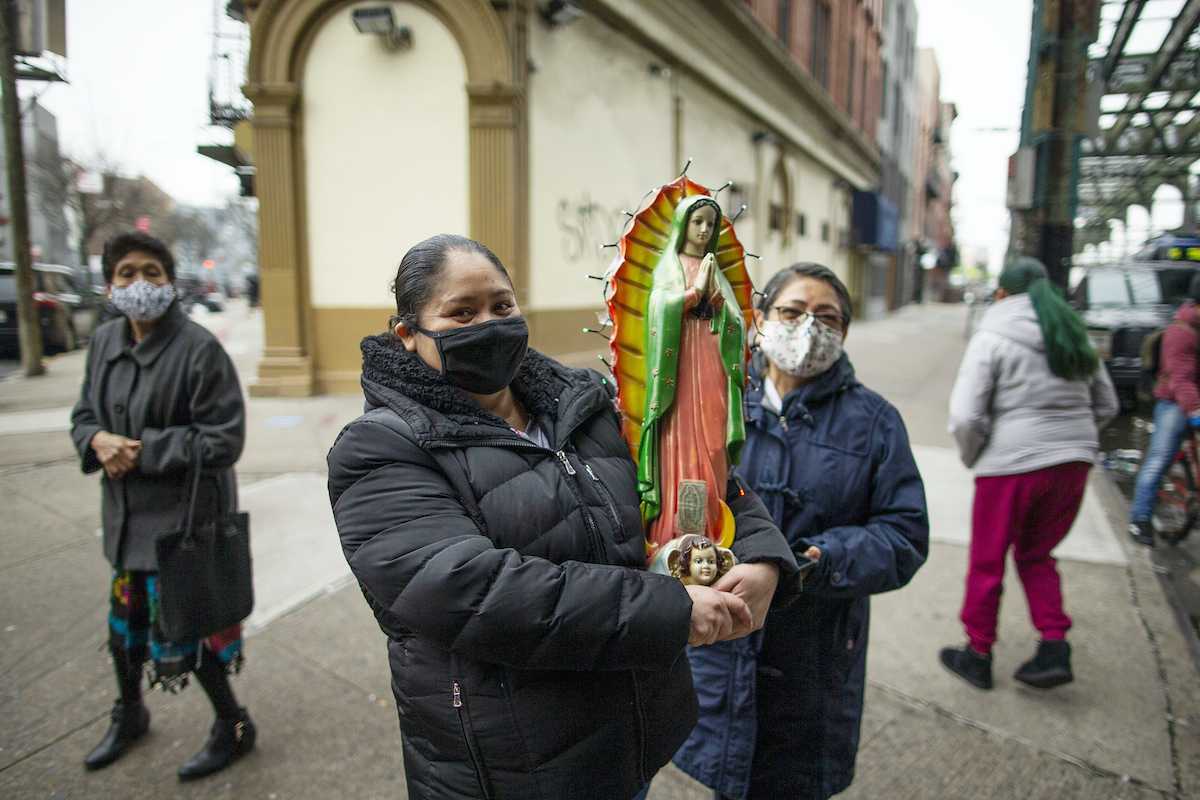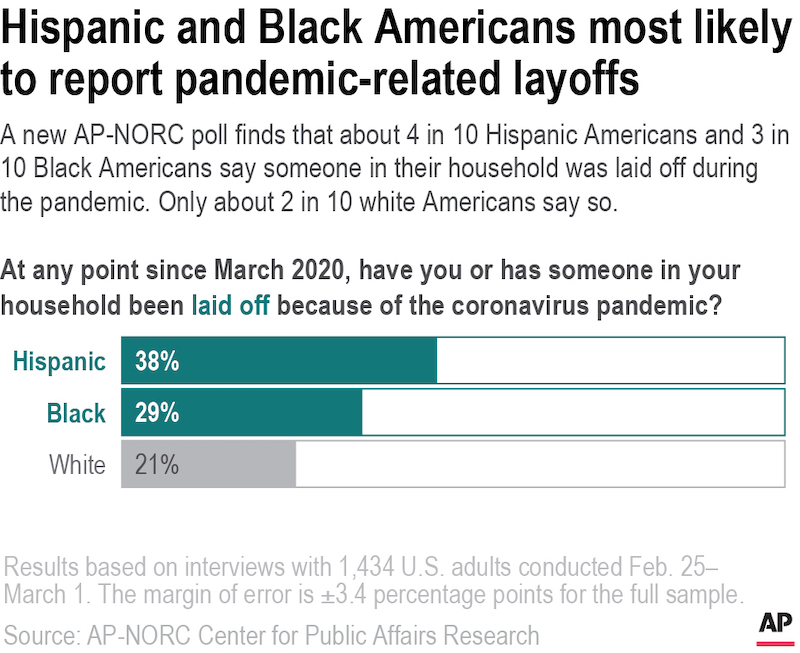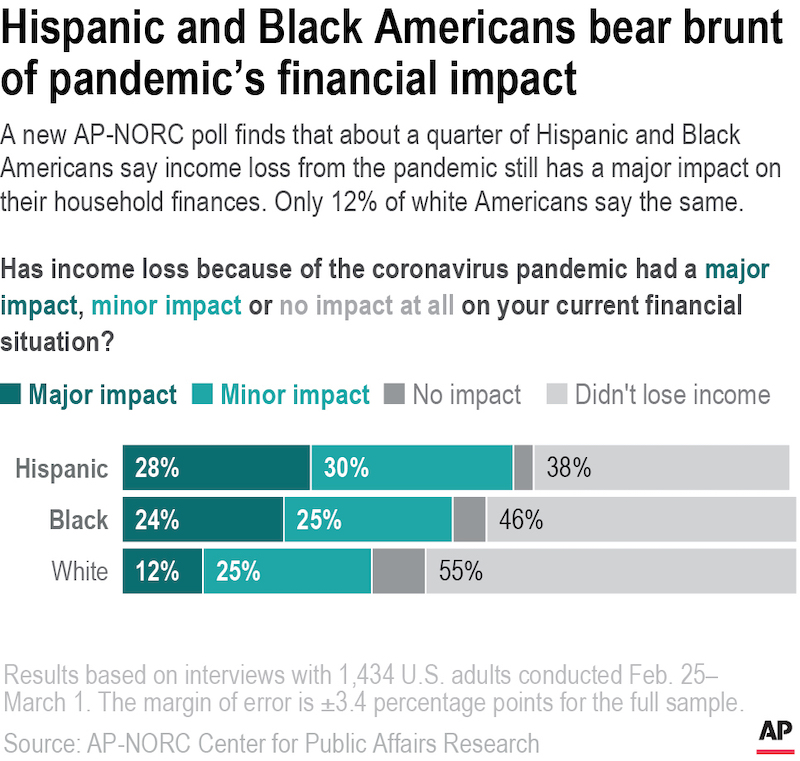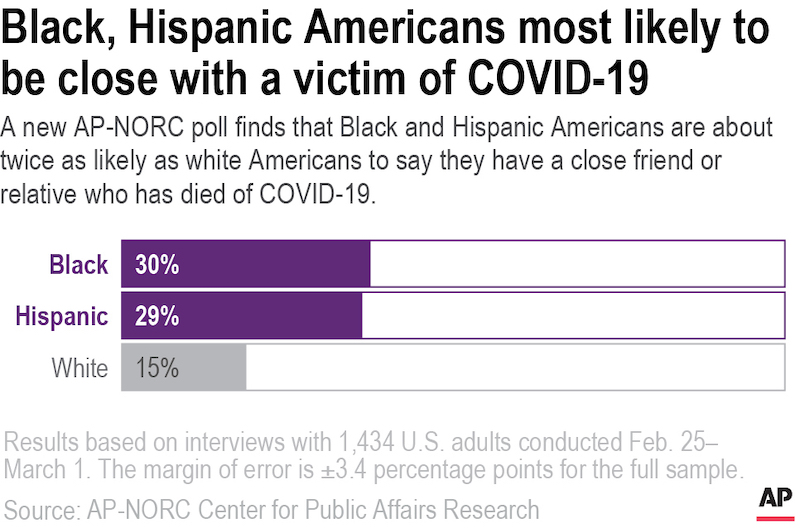

Mexican migrants carry a statue of the Virgin of Guadalupe in Brooklyn, New York, Saturday, December 12, 2020. The Hispanic community in the U.S. has been one of the groups most affected by the COVID-19 pandemic, reducing its income as millions were not able to access government help due to their irregular migratory status. (AP Photo/Eduardo Muñoz Alvarez)
By AARON MORRISON, KAT STAFFORD and EMILY SWANSON, Associated Press
NEW YORK (AP) — A year ago, Elvia Banuelos’ life was looking up. The 39-year-old mother of two young children said she felt confident about a new management-level job with the U.S. Census Bureau. She would earn money to supplement the child support she receives to keep her children healthy, happy and in daycare.
But when the coronavirus was declared a global pandemic last March, forcing hundreds of millions of people into strict lockdown, Banuelos’ outlook changed. The new job fell through, the child support payments stopped because of a job loss and she became a stay-at-home mom when daycares shuttered.
“The only thing I could do was make my rent, so everything else was difficult,” said Banuelos, of Orland, California.
Millions of Americans have experienced a devastating toll during the yearlong coronavirus pandemic, from lost loved ones to lost jobs. More than 530,000 people have died in the United States. Those losses haven’t hit all Americans equally, with communities of color hit especially hard by both the virus and the economic fallout.
A new poll from The Associated Press-NORC Center for Public Affairs Research shows that compared with white Americans, Black and Hispanic Americans are more likely to have experienced job and other income losses during the pandemic, and those who have lost income are more likely to have found themselves in deep financial holes.
That’s on top of Black and Hispanic Americans being more likely than white Americans to say they are close to someone who has died from COVID-19 and less likely to have received a vaccination. The pandemic has killed Black and Hispanic Americans at rates disproportionate to their population in the U.S., according to the latest data from the Centers for Disease Control and Prevention.
Banuelos, who identifies as Latina, said the disparity in pandemic experiences between “the upper class and people who are in a tighter situation” became glaringly clear to her early on in the pandemic. Even after two rounds of federal direct stimulus checks, she felt she was further behind than well-off Americans.
The relief “didn’t last that long,” Banuelos said.
Overall, 62% of Hispanic Americans and 54% of Black Americans have lost some form of household income during the pandemic, including job losses, pay cuts, cuts in hours and unpaid leave, compared with 45% of white Americans.
For other racial and ethnic groups, including Asian Americans and Native Americans, sample sizes are too small to analyze in the AP-NORC poll.
Jeremy Shouse, a restaurant manager from North Carolina, saw his hours greatly reduced during the early months of the pandemic when the small business was forced to shut down. Shouse, a 33-year-old Black man, said the restaurant has since reopened but went from making more than $5,000 in-house per day prior to the pandemic to only $200 on some days.


A new AP-NORC poll finds that about 4 in 10 Hispanic Americans and 3 in 10 Black Americans say someone in their household was laid off during the pandemic. Only about 2 in 10 white Americans say the same.
“One year later and things still aren’t the same,” Shouse said, adding his wages have dropped 20%.
About 6 in 10 Hispanics and about half of Black Americans say their households are still facing the impacts of income loss from the pandemic, compared with about 4 in 10 white Americans. Black and Hispanic Americans are also especially likely to say that impact has been a major one.


“We find that systemic racism plays a huge role in this process,” said Rashawn Ray, a fellow in governance studies at the Brookings Institute who co-authored a recent report on racial disparities and the pandemic in Detroit. “I think what we’re going to see once the dust settles is that the racial wealth gap has actually increased.”
There have long been racial disparities in how Americans experience economic downturns and recessions. However, following a recovery from the Great Recession and well into the Trump administration, the unemployment gap between Black and white Americans narrowed amid strong job growth and economic activity. But a recent analysis from the Federal Reserve Bank of New York found a gap that had declined to as little as 3 percentage points rose to 5.4 percentage points last August, erasing some of the gains made during the recovery.
The AP-NORC poll also finds Hispanic Americans are especially likely to think it will take a long time to dig their way out of the financial hole. About half of Hispanics say that they are still feeling the effects of income loss and that it will take at least six months to recover financially. About a third of Black Americans say the same, compared with about a quarter of white Americans.
Forty-one percent of Hispanic Americans say their current household income is lower than it was at the start of the pandemic, compared with 29% of Black Americans and 25% of white Americans.
For people of color, the trauma experienced due to economic turmoil has been compounded by immense personal losses. About 30% of Black and Hispanic Americans say they have a close friend or relative who has died from the coronavirus since last March, compared with 15% of white Americans.


A new AP-NORC poll finds that Black and Hispanic Americans are about twice as likely as white Americans to say they have a close friend or relative who has died of COVID-19.
Debra Fraser-Howze, founder of Choose Healthy Life, an initiative working to address public health disparities through the Black church, said she is confident in the Black community’s ability to recover economically and medically.
“The emergency economic situation of the community is dismal,” Fraser-Howze said, “and it’s going to be worse for a long time. But we are a community of survivors. We came through slavery and Jim Crow. We figured out how to stay alive. I do believe and have faith that our community will come back.”
***
Swanson reported from Washington. Morrison, who reported from New York, and Stafford, who reported from Detroit, are members of the AP’s Race and Ethnicity team.
The AP-NORC poll of 1,434 adults was conducted February 25-March 1 using a sample drawn from NORC’s probability-based AmeriSpeak Panel, which is designed to be representative of the U.S. population. The margin of sampling error for all respondents is plus or minus 3.4 percentage points.


